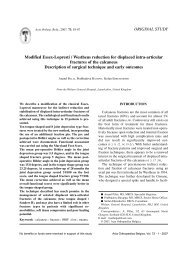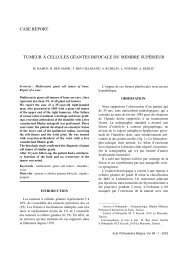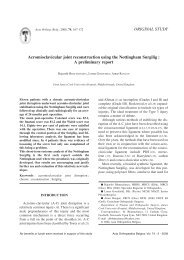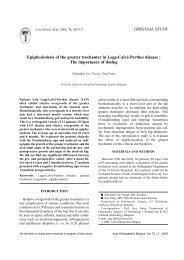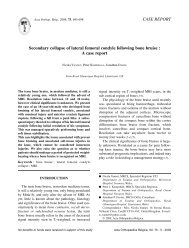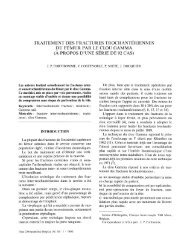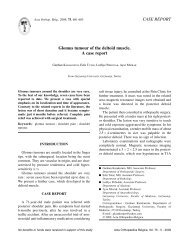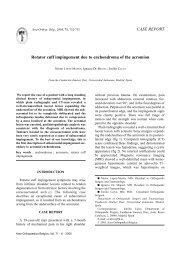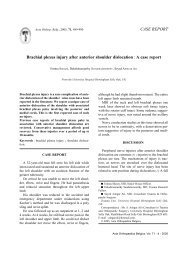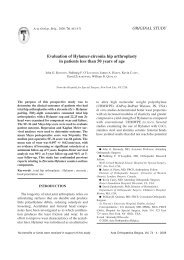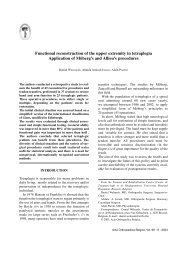download - Acta Orthopaedica Belgica
download - Acta Orthopaedica Belgica
download - Acta Orthopaedica Belgica
You also want an ePaper? Increase the reach of your titles
YUMPU automatically turns print PDFs into web optimized ePapers that Google loves.
410 I. J. HARDING, I. M. MORRISrecovery of an ulnar nerve lesion, although it is notpossible to comment on this from our data.We do not wish it to be misconceived that nonoperativetreatment is in any way better than operativetreatment from this study. We use non-operativetreatment for the ‘less severe’ painless caseswith sensory changes alone or in those with nonprogressivelongstanding motor lesions. The factthat 21% of cases refractory to non-operative treatmentare referred for surgery is due to our closemonitoring of lesions enabling us to change ourtreatment plan accordingly. Outcomes for nonoperativetreatment alone are better than operativeas noted in table VI, but this does not equate to nonoperativetreatment being better per se, as operativetreatment is used for the painful, progressive andrefractory cases in our unit. Indeed, it is possiblethat if operative treatment was used for all lesions(including ‘sensory’ only) then it would be moresuccessful than non-operative measures. This couldonly be determined by a prospective randomizedstudy to compare the two treatment modalities forulnar nerve lesions at the same site, with similaraetiology and chronicity. Ethical approval and adequatenumbers of cases would be very difficult toachieve.In summary, our study shows that ulnar neuropathyis a relatively common condition occurringpredominantly in males at the elbow. Bilaterality isnot uncommon and should always be excluded.Many aetiological factors have been identified althoughthis is often not possible and we term thesecases ‘idiopathic’. The most common defined causesinclude injury, arthritis, repeated pressure andthose as a result of injudicious patient positioningon the operating table during surgery. Ulnar neuropathyas a result of acute injury has a poor prognosiswhereas those as a result of repeated pressureand inflammation respond well to treatment.We feel strongly that non-operative treatmenthas an important role to play in the management ofulnar neuropathy. Unlike non-operative treatment,surgery is not without its complications and shouldbe reserved for those patients who have pain, exhibitmotor symptoms that are progressive or in thosepatients who have failed to respond to non-operativetreatment. We believe that patients undergoingsurgery should be counseled that the main aim is toprevent further deterioration and that the degree ofrecovery depends to some extent on the chronicityand aetiology of the lesion. This protocol necessarilyrequires diligent and careful continual assessmentof the patient at regular intervals by bothclinical and electrophysiological investigation.REFERENCES1. Bartels RH, Menovsky TH, Van Overbeeke JJ,Verhagen WI. Surgical management of ulnar nerve compressionat the elbow : an analysis of the literature. JNeurosurg 1998 ; 89 : 722-727.2. Bradshaw DY, Shefner JM. Ulnar neuropathy at theelbow. Neurol.Clin 1999 ; 17 : 447-460.3. Contreras MG, Warner MA, Charboneau WJ,Cahill DR. Anatomy of the ulnar nerve at the elbow :potential relationship of acute ulnar neuropathy to genderdifferences. Clin Anat 1998 ; 11 : 372-378.4. Dellon AL, MacKinnon SE. Injury to the medial antebrachialcutaneous nerve during cubital tunnel surgery. JHand Surg 1985 ; 10-B : 33-36.5. Dellon AL. Review of treatment results for ulnar nerveentrapment at the elbow. J Hand Surg 1989 ; 14-A : 688-699.6. Dellon AL, Hament W, Gittelshon A. Non-operativemanagement of cubital tunnel syndrome : an eight yearprospective study. Neurology 1993 ; 43 : 1673-1677.7. Gabel GT, Amadio PC. Reoperation for failed decompressionof the ulnar nerve in the region of the elbow. JBone Joint Surg 1990 ; 72-A : 213-219.8. Geutjens GG, Langstaff RJ, Smith NJ, Jefferson D,Howell CJ, Barton NJ. Medial epicondylectomy or ulnarnerve transposition for ulnar neuropathy at the elbow? JBone Joint Surg 1996 ; 78-B : 777-779.9. Khoo D, Carmichael SW, Spinner RJ. Ulnar nerve anatomyand compression. Orth Clin North Am 1996 ; 27 :317-338.10. Kurvers H, Verhaar J. The results of operative treatmentof medial epicondylitis. J Bone Joint Surg 1995 ; 77-A :1374-1379.11. Leffert RD, Dorfman HD. Antebrachial cyst in rheumatoidarthritis –surgical findings. J Bone Joint Surg 1972 ;54-A : 1555-1557.12. McGowan AJ. The results of transposition of the ulnarnerve for traumatic ulnar neuritis. J Bone Joint Surg 1950 ;32-B : 293-301.13. McKee MD, Jupiter JB, Bosse G, Goodman L. Outcomeof ulnar neurolysis during post-traumatic reconstruction ofthe elbow. J Bone Joint Surg 1998 ; 80-B : 100-105.14. Miller RG. Ulnar nerve lesions. In : Brown WF, BoltonCF, eds. Clinical Electromyography. Stoneham, MA :Butterworths, 1987 : 99-116.<strong>Acta</strong> Orthopædica <strong>Belgica</strong>, Vol. 69 - 5 - 2003



